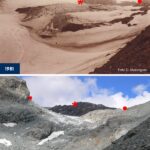GeoClimAlp (Geomorphological impacts of Climate change in the Alps) is a research group of the Research Institute for Geo-hydrological Protection established with the intent to deepen and improve the knowledge on the role of climate change in the morphogenesis of the alpine environment in general and of high-altitude environments in particular. The geological-morphological and climatic-hydrologic research fields are the main ones to be integrated in the scientific activities of the research group.
General objective: Carry out organic and integrated researches on the interaction between climate change and geomorphological dynamics in the alpine environment, with specific reference to natural instability resulting therefrom.
 Research activities: the activities currently carried out by GeoClimAlp are mainly oriented on the study of natural instabilities occurring in mountain environments, with emphasis on morphodynamic processes in the glacial and periglacial environment, on changes taking place due to the change climate, and on related geohazards. For these purposes, a systematic activity of documentation of instability events that occur in mountain areas is carried out, with particular attention to paroxysmal events in high-altitude alpine environments, to the recent evolution of glaciers and of glacierized and recently deglaciated areas.
Research activities: the activities currently carried out by GeoClimAlp are mainly oriented on the study of natural instabilities occurring in mountain environments, with emphasis on morphodynamic processes in the glacial and periglacial environment, on changes taking place due to the change climate, and on related geohazards. For these purposes, a systematic activity of documentation of instability events that occur in mountain areas is carried out, with particular attention to paroxysmal events in high-altitude alpine environments, to the recent evolution of glaciers and of glacierized and recently deglaciated areas.
In order to achieve the above mentioned objectives, the geological-geomorphological research field is integrated with the climatic-hydrologic one. In accordance to this approach, investigations include: the study of climate variability and trends in the alpine environment through time series analysis, the analysis of precipitation and thermal conditions associated to morphodynamic processes in glacial and periglacial environments, the monitoring of key climate variables measured at ground level in glacial basins, and the study of the relations between these variables and large-scale circulation patterns.
 Context of reference: The Alpine environment, and in particular the high-altitude one, is responding quickly and with great intensity to climate change, through evidences of geomorphological, hydrological and ecological type. Mountain glacier shrinkage and related outcropping of rock walls and debris, changes of the precipitation and temperature patterns and of the hydrological regimes, the shift of flora and fauna species to higher altitudes than the habitat they belong to, are some of the main terrestrial indicators of climatic change. The impact of these changes on slope stability, water resources and human activities is remarkable: however, the understanding of the ongoing phenomena and the forecasting of future scenarios still show large uncertainty.
Context of reference: The Alpine environment, and in particular the high-altitude one, is responding quickly and with great intensity to climate change, through evidences of geomorphological, hydrological and ecological type. Mountain glacier shrinkage and related outcropping of rock walls and debris, changes of the precipitation and temperature patterns and of the hydrological regimes, the shift of flora and fauna species to higher altitudes than the habitat they belong to, are some of the main terrestrial indicators of climatic change. The impact of these changes on slope stability, water resources and human activities is remarkable: however, the understanding of the ongoing phenomena and the forecasting of future scenarios still show large uncertainty.
Enjoy the navigation!
